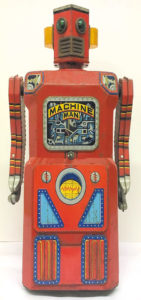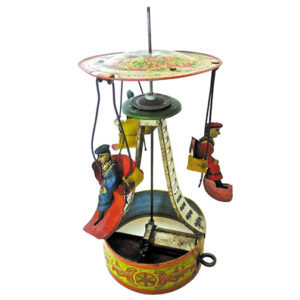 By Anne Gilbert
By Anne Gilbert Read this and shed a tear with me! Back in the late 1950s my son received one of the hottest toys on the market for Christmas. It was a bright red, tin plate robot named “Machine Man” that ran on a battery. It was one of a set of five different designs produced in Japan. The box was thrown away and eventually “Machine Man” ended up in the trash, replaced with another toy. Fast forward to March, 2019 and a Morphy’s toy auction. A “Machine Man” toy fetched $86,000. A world record for a toy.
Over the years many versions of a similar toy called “Mr. Machine” were made by American toy makers, such as “Ideal.”
Children and adults have always been fascinated by toys that could perform types of action when a key was turned or battery operated. Surprisingly not all old toys fetch thousands of dollars, and they may date back to the 19th century. In fact from the late 19th to early 20th century tin toys were made to perform many tricks. One of the most famous toy makers was Ernst Paul Lehmann, known for his painted clockwork and tin lithographed toys that did a variety of intricate tricks. He started his toy business in 1881, Brandenburg, Prussia. They originally sold for pennies.
Tin toys were made from sheet iron plated with a protective layer of tin to keep them from rusting. Historically, in the 19th century with the development of powered machinery and the invention of chromolithography, it was possible to turn out thousands of toys inexpensively. Nuremberg, Germany became the chief maker and exporter. However, that changed after World War 1. By the 1920s and 30s, with Germany suffering from defeat, the tin-plated toy market had shifted to the United States and Japan.
 Just before World War 11, Germany was once again making quality tin-plated toys. Up to the 1950s they were marked “Made in the U.S. Zone.” Those made in post-war Japan were marked “Occupied Japan.” Since they were made for a brief time many collectors specialize in them.
Just before World War 11, Germany was once again making quality tin-plated toys. Up to the 1950s they were marked “Made in the U.S. Zone.” Those made in post-war Japan were marked “Occupied Japan.” Since they were made for a brief time many collectors specialize in them. CLUES: Reproductions are a problem with the early German toys as well as Robots. Lehmann toys have been widely reproduced. They are being made in China and have the Lehmann mark “EPL” in a monogram. Clues to age are if the paint is too bright on the old German toys the piece is either a reproduction or has been touched up. Moveable toys should move and if a key wind up have the key. Many 50s toys have been re-issued. among them are Paya of Spain and Schuco toys made under the trademarked GAMA. Beware of “married” toys. This means new parts have been added that didn’t originally belong. Toys with original boxes usually double their value. PHOTO (1) 1950s “Mr. Machine” sold for $86 , 100.00. CREDIT : Morphy’s Toy auction, Denver, PA PHOTO (2) Tin toy clockwork carousel. CREDIT : 1st dibs















Follow Us